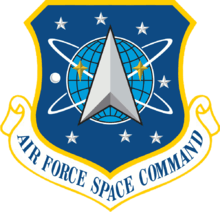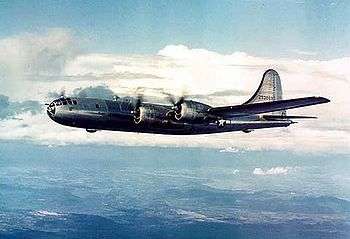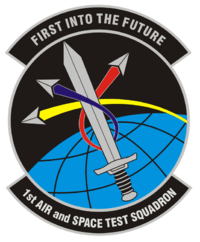1st Air and Space Test Squadron
1st Air and Space Test Squadron
 | |
|---|---|
|
1st Air and Space Test Squadron emblem | |
| Active | 2006–Present |
| Country |
|
| Branch |
|
| Part of | Air Force Space Command |
| Garrison/HQ | Vandenberg AFB |
| Motto(s) | First Into The Future |
| Decorations | Air Force Outstanding Unit Award |
The 1st Air and Space Test Squadron is a unit of the 30th Space Wing of the United States Air Force, responsible for spacelift and test operations.
The squadron's operations include launching of the Minotaur I and Minotaur IV and Pegasus rockets; as well as testing the Boeing Interceptor and Minotaur II target vehicles.[1]
Mission
The squadron's mission is to provide complete service launch and test operations for current and future space launch vehicles, targets, interceptors and experimental space systems.
History
World War II
.png)
The squadron was established by Headquarters, United States Army Air Corps in early 1940 as the 1st Photographic Squadron.[2] It performed aerial mapping primarily over the northeastern United States prior to the Pearl Harbor Attack using obsolescent cargo and Martin B-10 bombers as aerial platforms. After the United States entry into World War II, equipped with Lockheed A-29 Hudsons, Beech C-45 Expeditors and Douglas A-20 Havocs (all in photographic reconnaissance configuration) and performed aerial photography and mapping in uncharted areas of Newfoundland, Labrador and Greenland for development of Northeast Transport Route for the movement of aircraft, personnel and supplies across the North Atlantic from the United States to Iceland and the United Kingdom.
The squadron re-equipped with long-range Consolidated B-24 Liberator reconnaissance aircraft and deployed to Alaska in late 1943, assisting in the establishment of landing fields in the Aleutian Islands; also to map uncharted areas of internal Alaska to establish Lend Lease aircraft emergency landing fields over trans-Alaska route from Ladd Field and Elmendorf Field to Nome.

The squadron was relieved from assignment in Alaska and returned to Continental United States. It deployed to the Mediterranean Theater of Operations across the South Atlantic Transport Route to North Africa in early 1944. It performed aerial surveys and mapping over Sicily; Italy and along the North African Coast and Middle East with B-24s and some Boeing B-17Fs converted to F-9 reconnaissance configuration over non-combat areas. It then deployed to India and China; performing unarmed long-range mapping of remote areas of the China-Burma-India Theater over combat areas in support of ground forces and strategic target identification over Indochina and the Malay Peninsula for follow-up raids by XX Bomber Command operating from India.
The unit returned to the United States in late 1944. It was equipped with very long range Boeing B-29 Superfortresses converted to F-13A reconnaissance configuration. It deployed to the Central Pacific Area and was assigned to Eighth Air Force in the Pacific Theater after the Japanese Capitulation. The squadron remained in the Western Pacific performing reconnaissance mapping flights over Japan, Korea and China. B-29s returned to the United States in early 1946 for storage or reassignment; unit largely demobilized on Okinawa, flying some light liaison and courier aircraft. It was inactivated in early 1947 and disbanded on 8 October 1948.[2]
Test Operations in the Pacific
The squadron replaced the 6400th Test Squadron, which had been organized in 1967, in 1969. It conducted weapons system evaluation, known as COMBAT SAGE, of F-4 aircraft, of F-15 aircraft from 1980, and of F-16 aircraft from 1982, until shortly before inactivation. It also trained visiting aircrews from other Pacific Air Forces units in weapons employment and tactics.
Lineage
1st Photographic Squadron (later 1st Reconnaissance Squadron)
- Constituted 1st Photographic Squadron on 22 December 1939.
- Activated on 1 February 1940
- Redesignated 1st Mapping Squadron on 13 January 1942
- Redesignated 1st Photographic Mapping Squadron on 9 June 1942
- Redesignated 1st Photographic Charting Squadron on 11 August 1943
- Redesignated 1st Photographic Reconnaissance Squadron, Very Heavy on 10 November 1944
- Redesignated 1st Reconnaissance Squadron, Very Long Range, Photographic-RCM on 4 October 1945
- Redesignated 1st Reconnaissance Squadron, Very Long Range, Photographic on 13 November 1945
- Inactivated on 10 March 1947
- Disbanded on 8 October 1948[3]
- Reconstituted, and consolidated with the 1st Test Squadronon 19 September 1985 as the 1st Test Squadron
1st Test Squadron (later 1st Air and Space Test Squadron)
- Constituted as 1st Test Squadron on 12 September 1969
- Activated on 15 October 1969
- Consolidated with the 1st Reconnaissance Squadron on 19 September 1985
- Inactivated on 30 October 1991
- Redesignated 1st Air and Space Test Squadron on 28 October 2003
- Activated on 1 December 2003
Assignments
|
|
Stations
|
|
Aircraft
|
|
|
Decorations
-

- Air Force Outstanding Unit Award
- 3 April 1975 – 31 May 31, 1975
- 1 July 1976 – 30 June 30, 1977
- 1 April 1980 – 31 March 1982
- 1 July 1985 – 30 June 30, 1987
- 1 June 1988 – 1 June 1990
-
_Streamer.png)
- Philippine Republic Presidential Unit Citation
- 21 July 1972 – 15 August 1972[4]
-
.png)
- American Theater of World War II[3]
-

- European Theater of World War II[3]
-
- Pacific Theater[3]
References
Notes
- ↑ Vandenberg AFB Fact Sheet: 1st Air and Space Test Squadron, 1 March 2010 (retrieved Dec 16, 2012)
- 1 2 Maurer, Maurer, ed. (1982) [1969]. Combat Squadrons of the Air Force, World War II (PDF) (reprint ed.). Washington, DC: Office of Air Force History. pp. 8–9. ISBN 0-405-12194-6.
- 1 2 3 4 5 6 Lineage, aircraft, theater service, and station information to 1948 in Maurer, Combat Squadrons, pp. 8-9
- ↑ AF Pamphlet 900-2, Unit Decorations, Awards and Campaign Participation Credits, Vol II Department of the Air Force, Washington, DC, 30 Sep 76 , p. 4
Bibliography
![]() This article incorporates public domain material from the Air Force Historical Research Agency website http://www.afhra.af.mil/.
This article incorporates public domain material from the Air Force Historical Research Agency website http://www.afhra.af.mil/.
- Maurer, Maurer, ed. (1983) [1961]. Air Force Combat Units of World War II (PDF) (reprint ed.). Washington, DC: Office of Air Force History. ISBN 0-912799-02-1. LCCN 61060979.
- Maurer, Maurer, ed. (1982) [1969]. Combat Squadrons of the Air Force, World War II (PDF) (reprint ed.). Washington, DC: Office of Air Force History. ISBN 0-405-12194-6. LCCN 70605402. OCLC 72556.
- AF Pamphlet 900-2, Unit Decorations, Awards and Campaign Participation Credits, Vol II Department of the Air Force, Washington, DC, 30 Sep 76



.jpg)